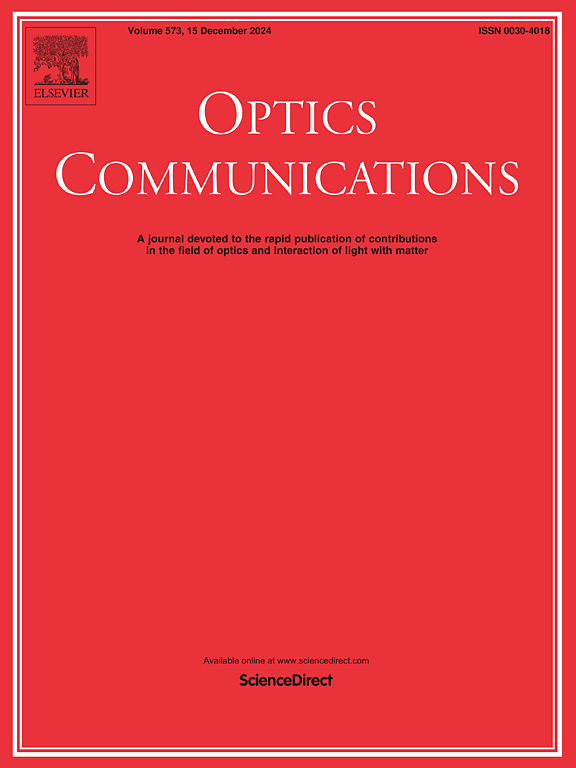Exploring the influence of hydrostatic pressure on the structural and optoelectronic behavior of cubic A3PCl3 (A = Mg, Ca) perovskite for solar cell applications
IF 2.2
3区 物理与天体物理
Q2 OPTICS
引用次数: 0
Abstract
This study utilizes first-principles simulations to investigate the optoelectronic properties of lead-free halide A3PCl3 (A = Mg, Ca) perovskites subjected to hydrostatic pressures from 0 to 60 GPa. As pressure increases, both the lattice parameter and cell volume decrease, indicating structural compression of the material. At ambient pressure, Mg3PCl3 and Ca3PCl3 demonstrate band gaps of 2.227 eV and 1.801 eV, respectively, indicating their potential for optoelectronic applications. The materials meet the Born stability criteria for mechanical stability throughout the examined pressure range, thereby confirming their stability under hydrostatic conditions. The perovskites demonstrate anisotropic elastic properties and possess high ductility, mechanical stability, and resistance to plastic deformation, all of which are improved under pressure. The mechanical analysis indicates that the materials maintain ductility and mechanical stability, exhibiting increased ductility with rising pressure. The optical properties were computed over the 0–35 eV energy spectrum under multiple pressures. Additionally, the optimized DFT values were employed in the proposed device construction FTO/ZnO/Mg3PCl3/Cu2O/Ni and FTO/ZnO/Ca3PCl3/Cu2O/Ni configurations attained optimal power conversion efficiencies (PCE) of around 15.29 % and 23.2 %, respectively, providing a safer, lead-free alternative to conventional Pb-based perovskites. Both materials exhibit remarkable ductility and compressive resistance, with bulk moduli substantially exceeding those of other perovskites such as CsPbX3 and Sr3AsCl3. The amalgamation of mechanical stability, superior ductility, and pressure resilience renders Mg3PCl3 and Ca3PCl3 exemplary candidates for applications necessitating both high optoelectronic performance and durability under fluctuating pressure conditions.
探讨静水压力对太阳能电池用立方A3PCl3 (A = Mg, Ca)钙钛矿结构和光电性能的影响
本研究利用第一性原理模拟研究了无铅卤化物A3PCl3 (A = Mg, Ca)钙钛矿在0 ~ 60 GPa静水压力下的光电性能。随着压力的增加,晶格参数和胞体体积都减小,表明材料的结构压缩。在环境压力下,Mg3PCl3和Ca3PCl3分别表现出2.227 eV和1.801 eV的带隙,表明它们具有光电应用潜力。在整个测试压力范围内,材料符合波恩的机械稳定性稳定性标准,从而确认其在流体静力条件下的稳定性。钙钛矿具有各向异性的弹性性能,具有较高的延展性、机械稳定性和抗塑性变形能力,在压力作用下,这些性能都得到了改善。力学分析表明,随着压力的增加,材料的延展性和力学稳定性都有所提高。在多种压力下,计算了0-35 eV能谱范围内的光学性质。此外,FTO/ZnO/Mg3PCl3/Cu2O/Ni和FTO/ZnO/Ca3PCl3/Cu2O/Ni结构的最佳功率转换效率(PCE)分别约为15.29%和23.2%,为传统的pb基钙钛矿提供了更安全、无铅的替代品。两种材料均具有显著的延展性和抗压性,体积模量大大超过CsPbX3和Sr3AsCl3等钙钛矿材料。Mg3PCl3和Ca3PCl3具有机械稳定性、优异的延展性和压力弹性,是在波动压力条件下需要高光电性能和耐用性的应用的典型候选材料。
本文章由计算机程序翻译,如有差异,请以英文原文为准。
求助全文
约1分钟内获得全文
求助全文
来源期刊

Optics Communications
物理-光学
CiteScore
5.10
自引率
8.30%
发文量
681
审稿时长
38 days
期刊介绍:
Optics Communications invites original and timely contributions containing new results in various fields of optics and photonics. The journal considers theoretical and experimental research in areas ranging from the fundamental properties of light to technological applications. Topics covered include classical and quantum optics, optical physics and light-matter interactions, lasers, imaging, guided-wave optics and optical information processing. Manuscripts should offer clear evidence of novelty and significance. Papers concentrating on mathematical and computational issues, with limited connection to optics, are not suitable for publication in the Journal. Similarly, small technical advances, or papers concerned only with engineering applications or issues of materials science fall outside the journal scope.
 求助内容:
求助内容: 应助结果提醒方式:
应助结果提醒方式:


